|
Chorale Melodies used in Bach's Vocal Works
Das alte Jahr vergangen ist |
|
Melody & Text | Use of the CM by Bach | Use of the CM by other composers |
| |
|
Melody & Text: |
|
The New Year hymn, “Das alte Jahr vergangen ist,” is first found, as a single stanza of eight lines (stanzas i and ii of the translation), in Clement Stephani’s Schöner ausserlessner deutscher Psalm, und anderer künstlicher Moteten und Geistlichen lieder XX (Nürnberg, 1568). Twenty years later Johannes Steurlein included the hymn, in six stanzas of four lines, in his Sieben und Zwantzigk Newe Geistliche Gesenge, Mit vier Stimmen Componiret und in druck der lieben Jugend zu gut verordnet (Erfurt, 1588). Three of the twenty-seven hymns in the collection are marked as Steurlein’s. “Das alte Jahr” is not among them, a fact which makes his alleged authorship doubtful. As early as 1609 the whole hymn was attributed to Jakob Tapp (d. 1630).
On the other hand, the melody (supra), which has borne the name of the hymn since 1608, is generally attributed to Johannes Steurlein, son of the first Lutheran pastor at Schmalkalden, where he was born in 1546. About 1580 he became Town-clerk of Wasungen, whence he passed in 1589 to Meiningen, of which he became Mayor. He died there in 1613. He was an excellent musician and published various melodies and four-part settings by himself. In 1588 his melody was set to Nikolaus Herman’s “Gott Vater, der du deine Sonn,” though the latter has a four-line stanza. In 1608 Erhart Bodenschatz attached the tune to “Das alte Jahr vergangen ist” in his Harmoniae angelicae Cantionum Ecclesiasticarum (Leipzig, 1608), and thenceforward the hymn and melody have been associated invariably. A four-lined reconstruction of the tune is set to the hymn in the Darmstadt Cantional of 1687, and a six-lined version of it, which J.S. Bach follows literally in the Orgelbuchlein and Choralgesänge, Nos. 55, 56 (BWV 288, BWV 289), is found in Witt (No. 57), but not earlier in print.
Source: Charles Sanford Terry: Johann Sebastian Bach, Bach’s Chorals, vol. 3 The Hymns and Hymn Melodies of the Organ Works (1921), pp 126-128 |
|
“Das alte Jahr vergangen ist” (J. Steurlein 1588, NLGB 44, NY) BWV 288 (6), BWV 289 (1, 2), BWV 614(OB), BWV 1091 (NC); German text is found on-line at Musicanet, http://www.musicanet.org/robokopp/Lieder/dasaltej.html. There is Catherine Winkworth 1863 English translation of all six stanzas, “The Old Year Now hath Passed way,” Cyber Hymnal, http://www.hymntime.com/tch/htm/o/y/e/oyearnwp.htm.
Source: Motets & Chorales for Turning Time (William L. Hoffman, February 28, 2015) |
|
Melody: Zahn 381ab
Composer: Johann Steurlein (1588) |
|
On the other hand, the melody (supra), which has borne the name of the hymn since 1608, is generally attributed to Johannes Steurlein, son of the first Lutheran pastor at Schmalkalden, where he was born in 1546. About 1580 he became Town-clerk of Wasungen, whence he passed in 1589 to Meiningen, of which he became Mayor. He died there in 1613. He was an excellent musician and published various melodies and four-part settings by himself. In 1588 his melody was set to Nikolaus Herman’s “Gott Vater, der du deine Sonn,” though the latter has a four-line stanza. In 1608 Erhart Bodenschatz attached the tune to “Das alte Jahr vergangen ist” in his Harmoniae angelicae Cantionum Ecclesiasticarum (Leipzig, 1608), and thenceforward the hymn and melody have been associated invariably. A four-lined reconstruction of the tune is set to the hymn in the Darmstadt Cantional of 1687, and a six-lined version of it, which J.S. Bach follows literally in the Orgelbuchlein and Choralgesänge, Nos. 55, 56, is found in Witt (No. 57), but not earlier in print.
Source: Charles Sanford Terry: Johann Sebastian Bach, Bach’s Chorals, vol. 3 The Hymns and Hymn Melodies of the Organ Works (1921), pp 126-128 |
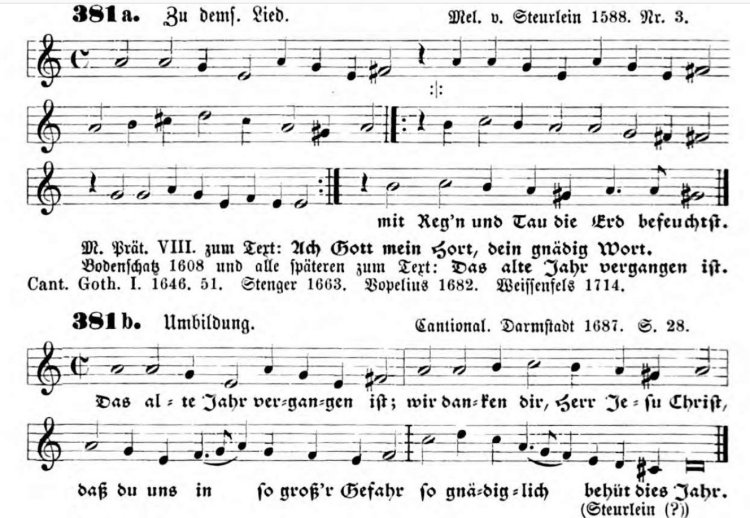 |
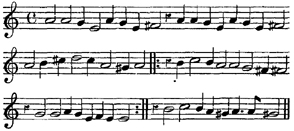 |
|
Ex 01: Melody: “Gott Vater, der du deine Sonn” |
|
Text: Das alte Jahr vergangen ist (NLGB 44)
Author: Johann Steurlein (verses 1-2: Erfurt 1588); Jakob Tapp (verses 3-6: 1588) |
|
Hymnal versions Bach may have known: |
|
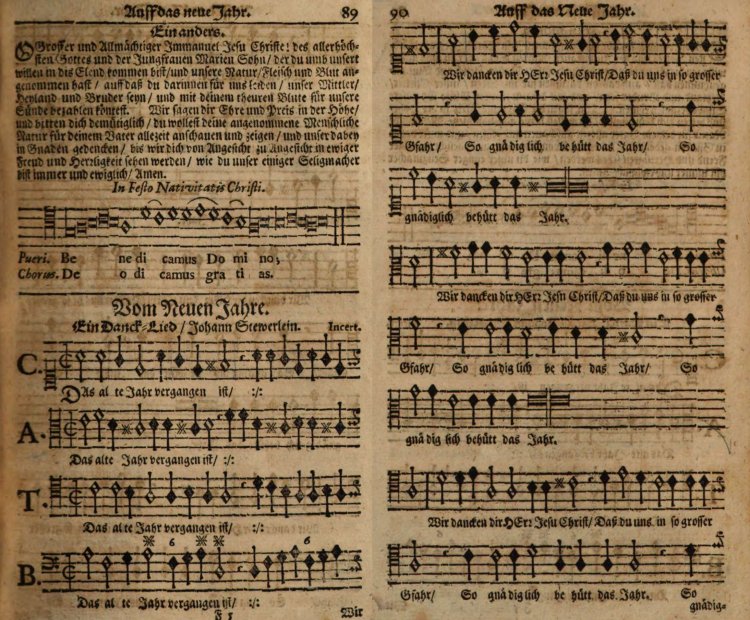
|
|
The first two pages of Das alte Jahr vergangen ist set to the melody of Johann Steurlein from the Neu Leipziger Gesangbuch |
| |
| |
|
Use of the Chorale Melody by Bach: |
|
Text: Das alte Jahr vergangen ist |
|
Chorale Das alte Jahr vergangen ist, BWV 288
Ref: RE 162; Br 162; KE 55; Birnstiel 166; Dietel 5; AmB 46II p.135; Penzel 129; BGA 35; BC F36.1 |
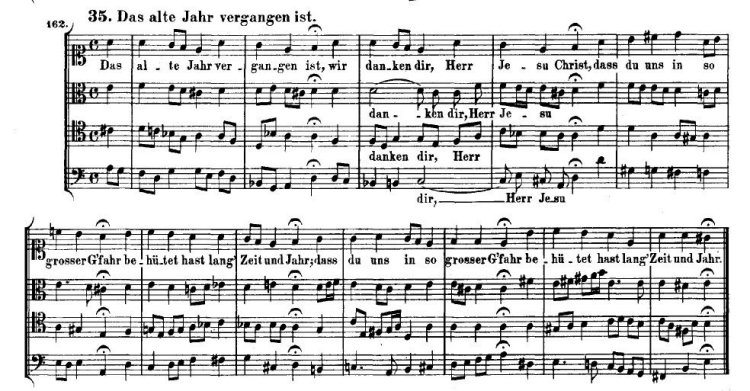 |
|
Chorale Das alte Jahr vergangen ist, BWV 289
Ref: RE 314; Br 313; KE 56; AmB 46II p.105; BGA 36; BC F36.2 |

 |
|
Untexted: |
|
Chorale Prelude Das alte Jahr vergangen ist (I), BWV 614 |
|
Though the hymn is a prayer for help and comfort during the coming New Year (the old year being referred to incidentally merely in the first stanza), J.S. Bach, influenced, perhaps, by the character of the melody, writes a threnody on the year that is gone, and wraps the tune in chromatic counterpoint expressing, in his idiom, poignant grief and regret. A chromatic grief motive is employed for the same purpose in the opening choruses of the B minor Mass (BWV 232) and the St Matthew Passion (BWV 244). It occurs also in the 8th Partita on “O Gott, du frommer Gott” (N. xix. 51), depicting the torture of the souls awaiting the Judgment summons, of which the corresponding stanza of the hymn speaks. In the Orgelbüchlein movement, “Christus, der uns selig macht,” J.S. Bach introduces it to picture the bitter anguish of Christ, of which the hymn tells (N. xv. 64). The same thought moves him to introduce it “adagissimo” in the final bar of “O Mensch, bewein’ dein’ Sünde gross” (N. xv. 69).
Schweitzer remarks that the striking major cadence is occasioned by “the consolatory conclusion of the first verse and of the poem in general.” In fact the major cadence is as old as the tune.
Source: Charles Sanford Terry: Johann Sebastian Bach, Bach’s Chorals, vol. 3 The Hymns and Hymn Melodies of the Organ Works (1921), pp 126-128 |
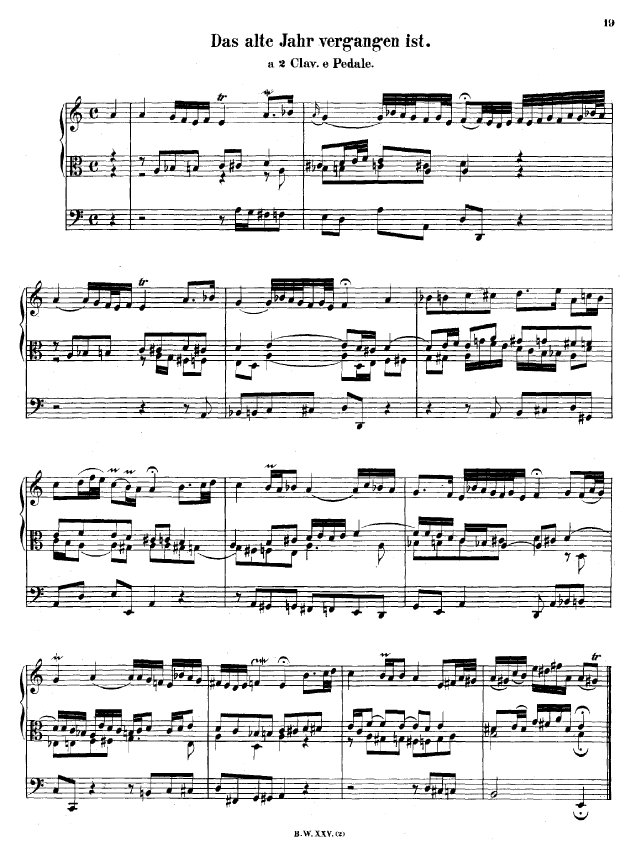 |
|
Chorale Prelude Das alte Jahr vergangen ist (II), BWV 1091 |
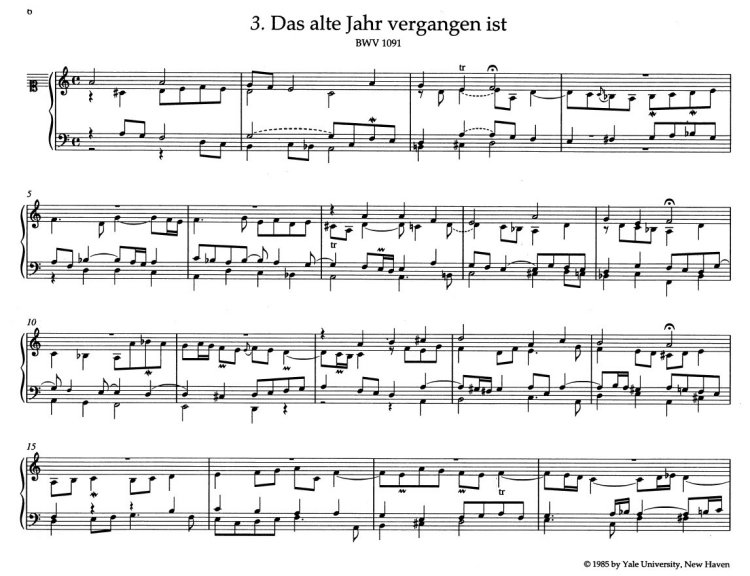 |
| |
| |
|
Use of the Chorale Melody by other composers: |
| |
| |
|
Sources: Bach Digital; BGA; Zahn
Photos from Gottfried Vopelius Neu Leipziger Gesangbuch (Vopelius 1682), were taken from a digital copy of the book downloaded from Bayerische Staatsbibliothek München. This copy is Out of copyright - non commercial re-use (Europeana Rights).
Prepared by Aryeh Oron (October 2018) |